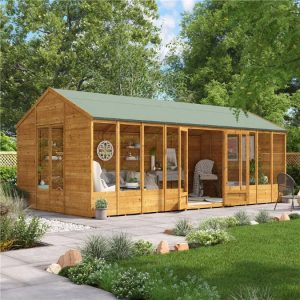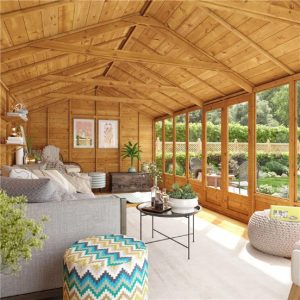A garden summerhouse offers endless fun possibilities for you and your family. Quality time is certainly at the forefront. If this sounds like something everyone at home would enjoy, we’ve got these summer house ideas to help you make it happen. Here, we’ll cover what to consider so you can enjoy your retreat for multigenerational use.
Check if You Need Planning Permission for Your Summer House

It’s a good rule of thumb to look into if planning permission is necessary for your garden building. Whether it’s a summer house for family use, a garden shed for storage, or something else, this remains the case. The reason is to make sure what you intend to install on your property adheres to building regulations and permitted development guidelines. Otherwise, your dream summer retreat could be a long way off.
Planning and getting permits might seem overwhelming at first, but they’re usually straightforward for small garden structures. Before making changes to your outdoor space, it’s a good idea to check with your local planning authority (LPA). They’ll be able to tell you if any additional permits are needed or if you need to contact anyone else before getting the green light on your construction plans.
Generally, your summer house may not need planning permission if it meets these requirements:
- The unit covers only half of the garden. The height must not exceed 3 metres with a pent roof or four metres with an apex roof. On top of this, the structure’s eaves must not exceed 2.5 metres.
- The summer house should occupy no more than half of the property’s land, and its interior should not exceed 30 square metres.
- The summer house should not exceed 2.5 metres in height.
Keep these factors in mind when shopping for a unit so you don’t have any unwanted outcomes later on. And always consult with your LPA to be on the safe side!
Work Out How You’ll Use Your Summer House

This part is where our summer house ideas get exciting! It’s even better once you find out that permission isn’t needed or you’ve got everything sorted and received the go-ahead to build. One way to get inspired is by looking at other projects to get in the mood. Here are a few of our favourite picks from the internet:
- Vikkie Lee – The Carpenters Daughter: This summer house was built during the 2020 lockdown. Vikkie documented her process, from creating the base and frame to cladding and felting the roof. It’s great example of a self-built summer house showing impressive DIY skills!
- Michael Crinnion – DIY Summer House: This large project was featured on Michael’s Medium profile. Crinnion himself admitted that this was the “biggest project [he’s] ever undertaken,” but it is clear that there are rewards to such hard work. On his website, he detailed the whole process, starting with laying the groundwork and constructing the floor frame.
- Budget Summer Garden Oasis – Real Homes: This couple’s DIY summer house, featured in Real Homes, is a true testament to what you can achieve on a low budget. Built at the back of a 1950s semi-detached house, this summer home was entirely DIY and cost under £1,200. From the foundation to the stud work to the roof, they constructed every aspect of their garden oasis while keeping costs as low as possible.
Prefabricated summer houses are a great option. If you’re feeling creative, DIY projects can be just as appealing. Check out these ‘Summer House Interior Ideas You Don’t Wanna Miss’ for more!
Budget Your Summer House Costs and Upkeep
The major factor in building from scratch or investing in a prefab summer house is the initial cost. The costs can vary depending on size, quality of building materials, finishings, and insulation. You can find units at a reasonable price from trusted stores like Garden Buildings Direct. If you have the means, please invest in a quality unit so you can enjoy it for many years.
Tip: Opt for a unit that can withstand the UK climate. Pressure treated summer house, for one, is a great option for the rainy and humid weather in the United Kingdom. Insulated panels may also be a good choice for certain areas of the UK, especially in the north. In fact, if you’re looking for a building you can use in all weathers, consider these insulated garden rooms.
Regular maintenance of summer houses is just as important to keep it that way. Take note, though, that winterising can be expensive. If you want to use your summer house in winter, consider installations like solar-powered radiant floor heating, an electric wood burner, and heated seating.
Read our ‘Summer House Maintenance Guide’ to find out more.
Round-up
These are just some of the summer house ideas worth considering if you want a retreat for multigenerational use. Careful planning and design are crucial, as you’ll want to enjoy the results for years. It might also be a good idea to reach out to experts for personalised advice if you run into any issues, e.g., with permits.
Make sure you select a design and materials that work well for your property and family. Winterising options are worthwhile, too, especially if you plan to use the garden room year-round.
